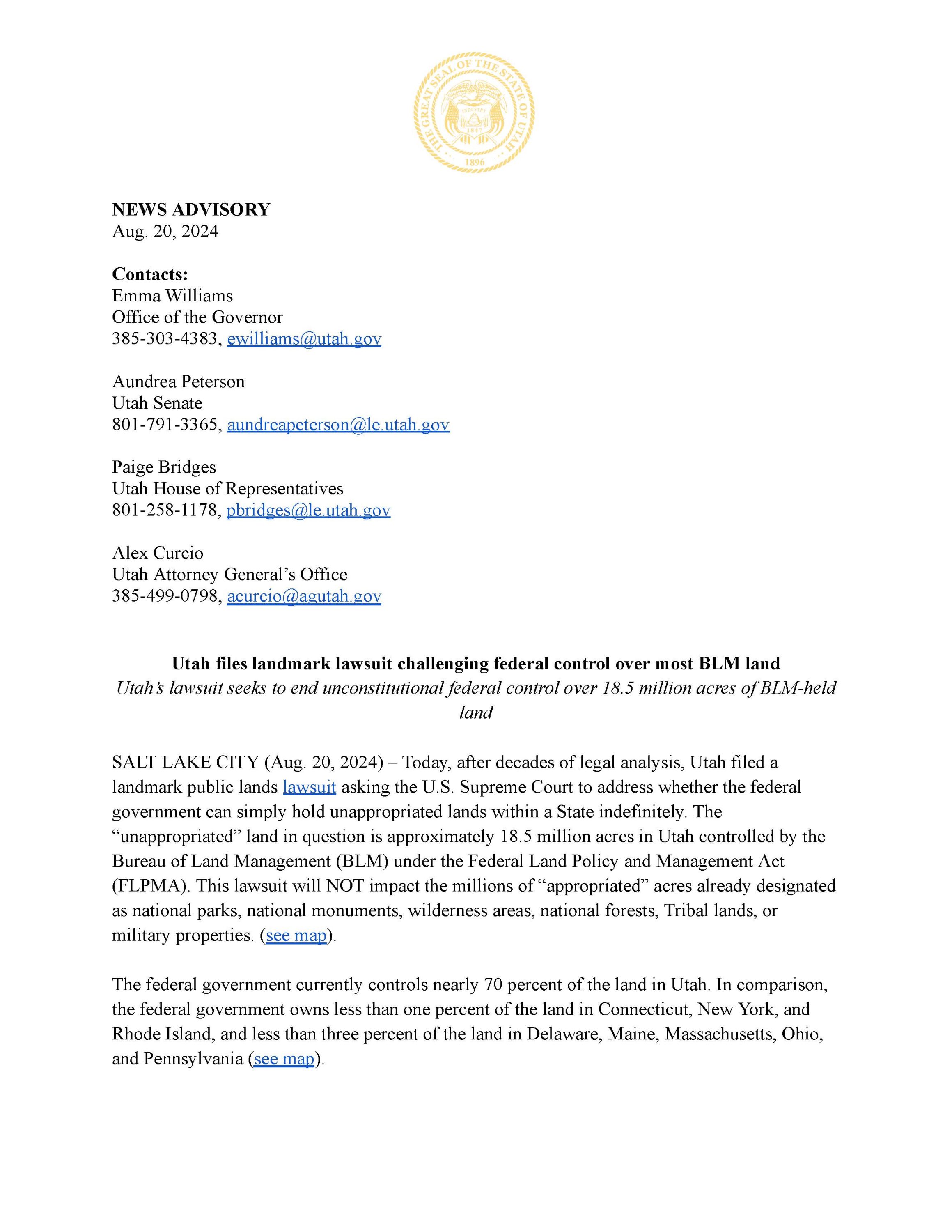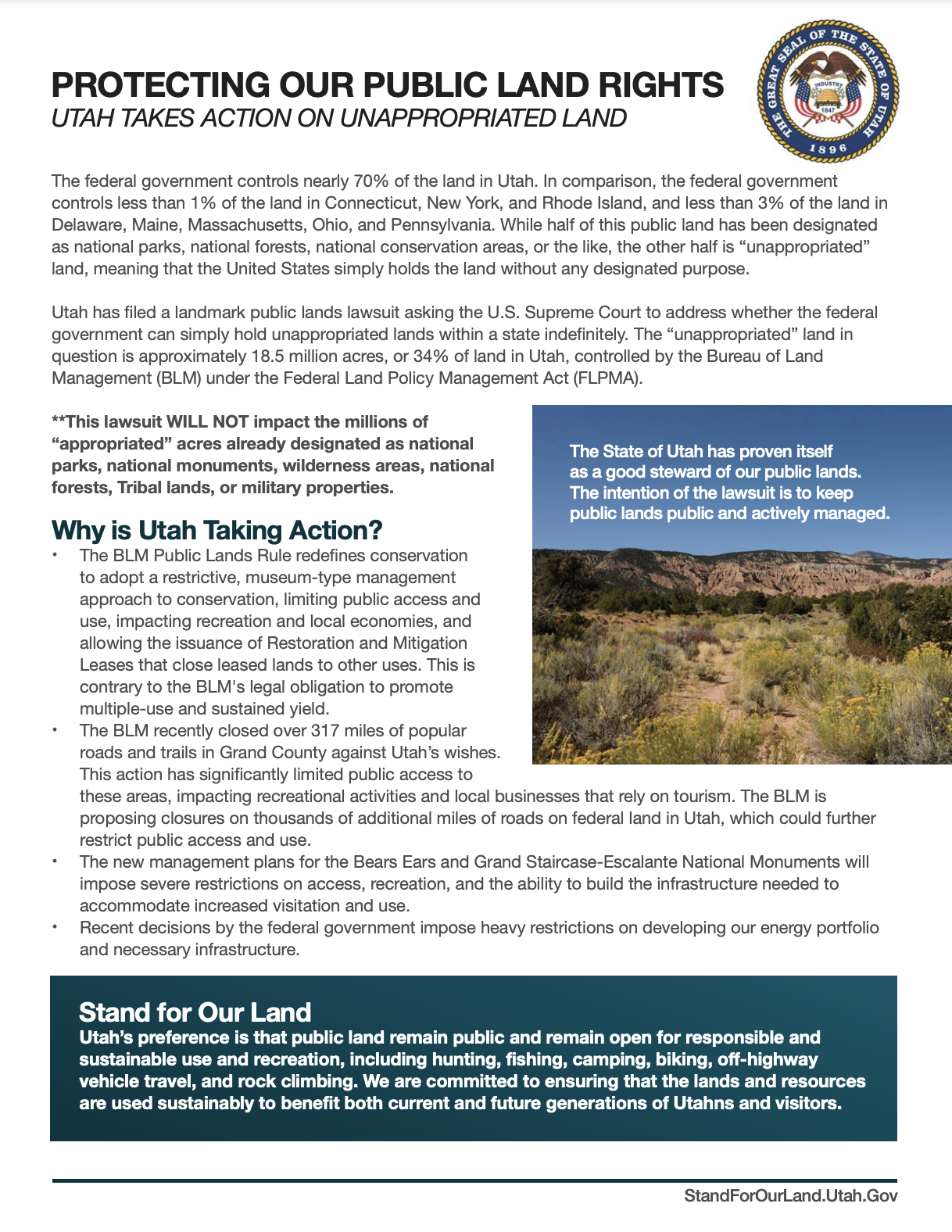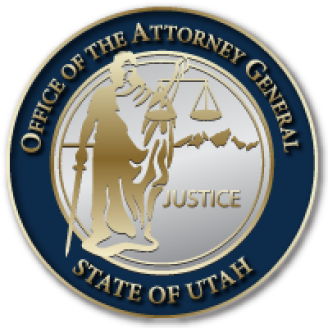
The federal government controls nearly 70% of the land in Utah. In comparison, the federal government controls less than 1% of the land in Connecticut, New York, and Rhode Island, and less than 3% of the land in Delaware, Maine, Massachusetts, Ohio, and Pennsylvania. While half of this public land has been designated as national parks, national forests, national conservation areas, or the like, the other half is “unappropriated” land, meaning that the United States simply holds the land without any designated purpose.
Utah has filed a landmark public lands lawsuit asking the U.S. Supreme Court to address whether the federal government can simply hold unappropriated lands within a state indefinitely. The “unappropriated” land in question is approximately 18.5 million acres, or 34% of land in Utah, controlled by the Bureau of Land Management (BLM) under the Federal Land Policy Management Act (FLPMA).

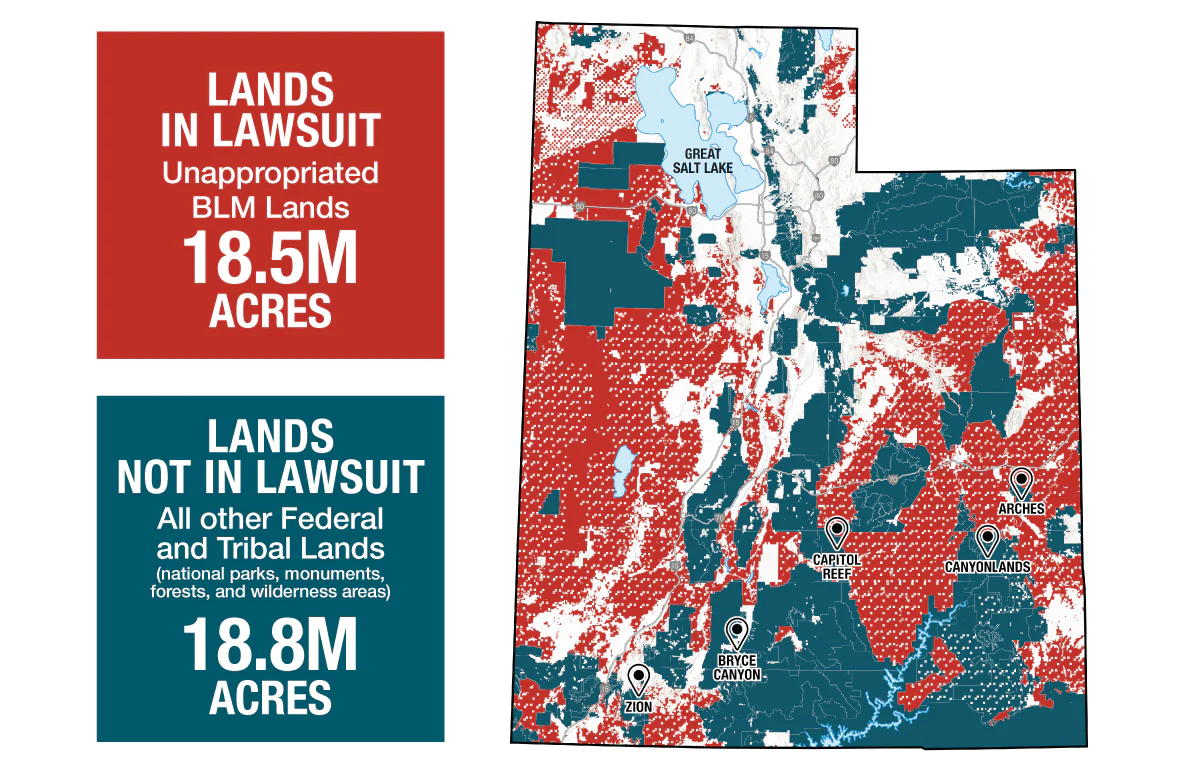
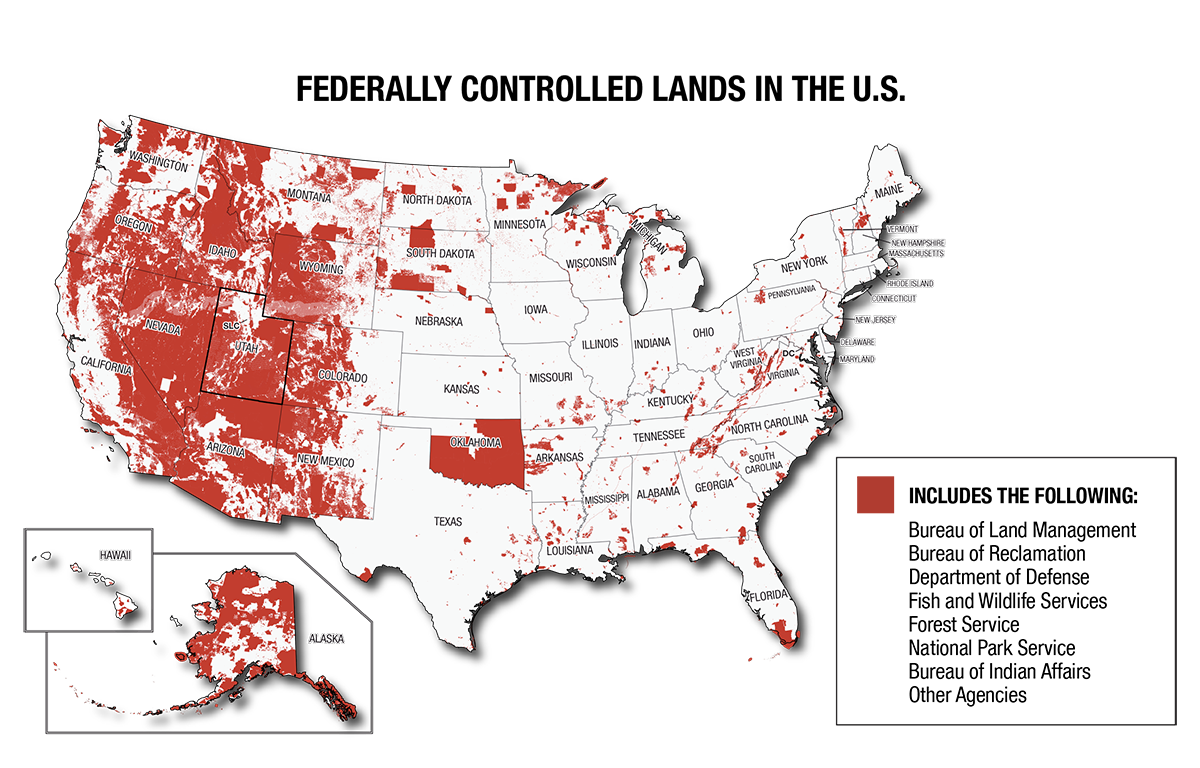
Frequently Asked Questions
The sole purpose of the lawsuit is to answer the constitutional question of whether or not the federal government can retain unappropriated lands in a state indefinitely, over the state's objection.
The state wants to see public lands remain in public hands and available to all Utahns and visitors of all ages and abilities to be managed for multiple uses for current and future generations.
The state encourages Utahns and visitors to support public lands being managed locally by the state of Utah.
A key challenge Utah currently faces is that the federal government continues to restrict public use of BLM lands. In many instances, these restrictions do not provide Utahns with the most efficient and effective land management, economic stability, and recreational opportunities.
After decades of legal analysis, the state of Utah has filed a landmark public lands lawsuit asking the U.S. Supreme Court to address whether the federal government can simply hold unappropriated lands within a state indefinitely. Unappropriated lands are those that the federal government simply holds without a congressionally defined purpose.
This lawsuit aims to definitively determine the constitutionality of BLM's extensive land ownership in Utah under Article I or the Property Clause of the U.S. Constitution.
In Utah, nearly 70% of the land is controlled by the federal government, only in Nevada does the BLM control a larger percentage of a state’s land. In comparison, the Federal Government controls less than 1% of the land in Connecticut, New York, and Rhode Island. The BLM controls nearly 22.8 million acres in Utah, almost 42% of Utah. Large-scale BLM land control is an anomaly in the United states, with almost all BLM land concentrated in Utah and ten other western states.
Of those 22.8 million BLM acres in Utah, the majority (approximately 18.5 million acres) are “unappropriated” BLM lands held by the federal government without any clear Congressional designation. These 18.5 million acres are the lands in question in the lawsuit.
No, this lawsuit WILL NOT impact the millions of “appropriated” acres already designated as national parks, national monuments, wilderness areas, national forests, national conservation areas,Tribal lands, or military properties.
The lawsuit is asking the U.S. Supreme Court to address whether the federal government can simply hold “unappropriated” lands within a state indefinitely.
From a legal standpoint, nothing in the text of the Constitution authorizes the U.S. government to simply retain huge swathes of unappropriated land within a state forever. To the contrary, the Framers of the Constitution carefully limited federal government power to hold land within the states.
The lawsuit is asking the U.S. Supreme Court to address whether the federal government can simply hold unappropriated lands within a state indefinitely. The Constitution never intended a federal agency to hold onto so much land in any state. The state of Utah is asking the U.S. Supreme Court to weigh in on this critical constitutional question we, and many western states, have had for decades.
The federal government’s expansive landholdings deprive Utah of a significant amount of sovereignty compared to other states, where Utah is unable to actively manage more than two-thirds of the land within its borders. Federal overreach prevents Utah from actively managing public lands, impacting recreation, local economies, and resource development.
The state’s preference is that public land remain in public hands and locally managed.
The federal government stopped disposing of public lands as per their constitutional mandate with the passage of the Federal Land Policy and Management Act (FLPMA) in 1976.
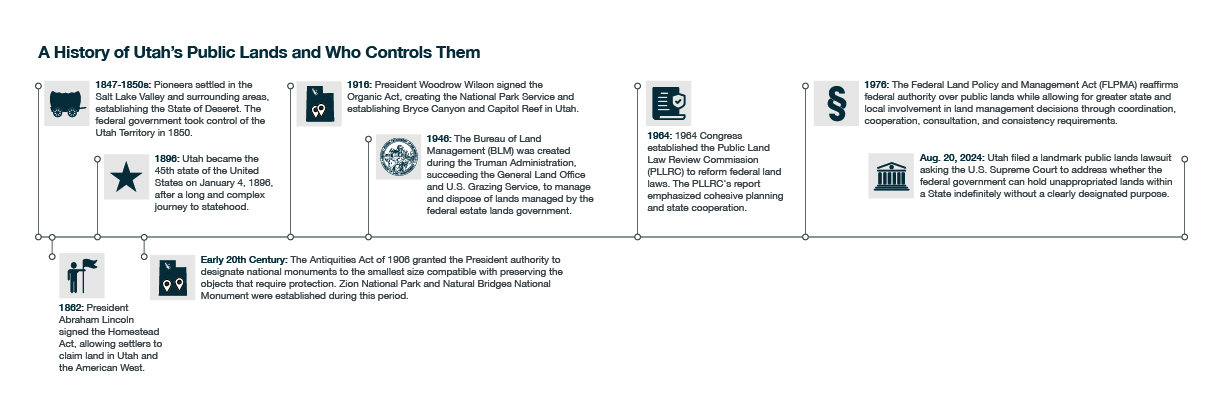
While this question of federal authority to retain public lands has been widely discussed and argued for decades, the federal government’s ongoing and proposed actions have created an immediate need for an answer from the Supreme Court. Under the control of the federal government, Utah public lands have become less and less public with each and every federal lands action coming out of Washington D.C.
The Bureau of Land Management (BLM) Public Lands Rule, signed as an executive rule this year, redefines conservation to adopt a restrictive, museum-type management approach to conservation, limiting public access and use, impacting recreation and local economies, and allowing the issuance of Restoration and Mitigation Leases that close leased lands to other uses. This is contrary to the BLM's legal obligation to promote multiple-use and sustained yield under the Federal Lands Policy and Management Act (FLPMA).
The BLM recently closed over 317 miles of popular roads and trails in Grand County against Utah’s wishes. This action has significantly limited public access to these areas, impacting recreational activities and local businesses that rely on tourism. The BLM is proposing closures on thousands of additional miles of roads on federal land in Utah, which could further restrict public access and use.
The new management plans for the Bears Ears and Grand Staircase-Escalante National Monuments will impose severe restrictions on access, recreation, and the ability to build the infrastructure needed to accommodate increased visitation and use.
Recent decisions by the federal government impose heavy restrictions on developing our energy portfolio and necessary infrastructure.
If the lawsuit is successful, Utah intends to take steps to acquire these BLM lands and actively manage them for public use. Should Utah acquire these lands, the state will manage them for multiple uses: to balance recreation, wildlife habitat, and conservation with other responsible uses such as energy production, livestock grazing, and sustainable resource development.
The Utah legislature created the Utah Department of Land Management in 2017 (Utah state Code 63L-9-102), which would come into existence if Utah were to acquire 250,000 or more acres of federal lands. The Utah Department of Land Management would manage these newly acquired lands under the Utah Public Lands Management Act (Utah state Code, Title 62L, Chapter 8), which outlines management processes and includes a prohibition against the privatization of these public lands, except in rare situations (Utah state Code 63L-8-104).
Utah would recognize valid existing rights on public lands such as outdoor recreation, dispersed camping, rock climbing, livestock grazing, mining, energy development, and energy transmission.
The state of Utah sends roughly $225 million in royalty payments on BLM controlled land to the federal government every year. These royalty payments could instead be used to actively manage the lands under Utah’s stewardship.
Should Utah prevail in the lawsuit, a more detailed economic analysis would be completed to assess the fiscal impact of managing the lands in the lawsuit in greater detail prior to potential acquisition.
Utah has a long history of working in partnership with local and federal agencies to improve and provide stewardship for Utah's public lands. Recent actions by the BLM undercut these efforts, making collaborative restoration projects increasingly difficult to implement. Under state management of unappropriated BLM land, Utah would expand these successful restoration and management efforts.
Utah’s Grazing Improvement Program (GIP) is dedicated to improving the health and sustainability of Utah’s rangeland. It provides grants and funding resources for ranchers, directs rangeland improvement programs and projects, and supports grazing management plan development. This program helps prevent the decline of public lands by using sustainable management practices. Utah has invested over $35 million in GIP projects, benefiting over 12 million acres statewide by working cooperatively with private landowners, local and federal agencies, and local partners to promote multiple-use management of public lands.
Utah’s state parks are well-visited and well-managed and play a vital role in sustaining the state’s tourism economy. In 2023, Utah’s 46 state-owned parks provided over 600 jobs and 6 million visitors with recreation opportunities throughout the state.
Every year, hundreds of wildfires burn on private, state and federal land in Utah. Wildfires that occur on state and unincorporated private lands are managed by the state. The state works with federal agencies and local fire departments to coordinate the suppression effort. The majority of all wildfires in Utah are extinguished before they exceed 10 acres. The state also has several programs that are focused around prevention, preparedness, mitigation and post-fire rehabilitation. These programs are in coordination with federal and local agencies to achieve the greatest amount of success on the landscape.
For over 100 years, Utah has used wildlife/waterfowl management areas (WMAs) to provide winter ranges with feed and shelter to help deer and other big game animals survive the snowy winter months. Utah and its partners manage these lands and implement habitat projects to help provide food and water to maintain healthy wildlife populations. These properties are owned and managed by the Utah Division of Wildlife Resources for conserving critical wildlife habitats, helping minimize and mitigate wildlife depredation on private property providing places where Utahns can go to hunt and fish. Currently, there are 194 WMAs throughout Utah, totaling over 500,000 acres or 780 square miles. Each WMA ranges from a couple of dozen to over 50,000 acres.
The state has approximately 150 DNR law enforcement officers (LEO) statewide, more than double the law enforcement presence of all the federal land management agencies combined. Our Utah Department of Natural Resources (DNR) LEOs have excellent working relationships with local law enforcement agencies across the state and are more dispersed so there are LEOs in nearly every corner of the state closer to the resources and recreation areas.
No, but the question has been one the state, and other states, have discussed and analyzed for decades.
Several years ago, Utah investigated the feasibility of transferring all public lands to Utah; we are not aware of any other states pursuing similar action currently. This only applies to unappropriated BLM lands.
Travel management planning and the Bureau of Land Management (BLM) Public Lands Rule are prime examples of federal policies not aligning with Utah values. These are stark departures from historical public land management on BLM lands as outlined in the Federal Land Policy Management Act (FLPMA). The state of Utah and all 29 counties have adopted resource management plans to enhance coordination with federal land management agencies. Unfortunately, federal agencies continue to ignore these state and local plans. One of the primary tenets of FLPMA is BLM’s requirement to be consistent with state and local plans, however, this consistency with state and local plans is not occurring.
Utah has entered into collaborative partnerships through the Watershed Water Restoration Initiative (WRI) and the Shared Stewardship program.
Utah has invested over $100 million in the Watershed Restoration Initiative. It has been an active partner in improving watershed health and biological diversity, water quality and yield, and opportunities for sustainable uses of natural resources. In partnership with state, federal, and local governments, conservation organizations, and private landowners, over 2.5 million acres of land have been treated, and entire ecosystems have become more resilient to disturbances like wildfire and drought.
Utah’s Shared Stewardship agreement provides a framework for the state of Utah and the US Forest Service to cooperate with the Natural Resources Conservation Service and water providers to identify forest health priorities focusing on restoration projects. The primary goals of the projects are protecting communities and watersheds from the threat of large, unwanted wildfires. Through Shared Stewardship, we are opening our conversations to include the state and the Forest Service and communities, industry, organizations, and users of our national forests. For example, the Parley’s Canyon Watershed Restoration Project was successfully implemented to reduce wildfire risk.
With the ability to manage our lands and resources less restrictively and benefit more from the economic impacts of managing for multiple uses and sustained yield, we anticipate continuing to fund active land management with state funding and federal funding.
The state is committed to keeping public lands in public hands and available to all Utahns and visitors of all ages and abilities to be managed for multiple uses for current and future generations.
The state statute prohibits the privatization of public lands except in rare circumstances. (Utah state Code, Title 62L, Chapter 8)
The state encourages Utahns and visitors to support public lands being managed locally by the state of Utah.
Media & Press
For media inquiries, please contact:
Robert Carroll, Office of the Governor
801-243-2290 | rcarroll@utah.gov
Hanna Seariac, Utah Attorney General
801-793-7713 | heseariac@agutah.gov
